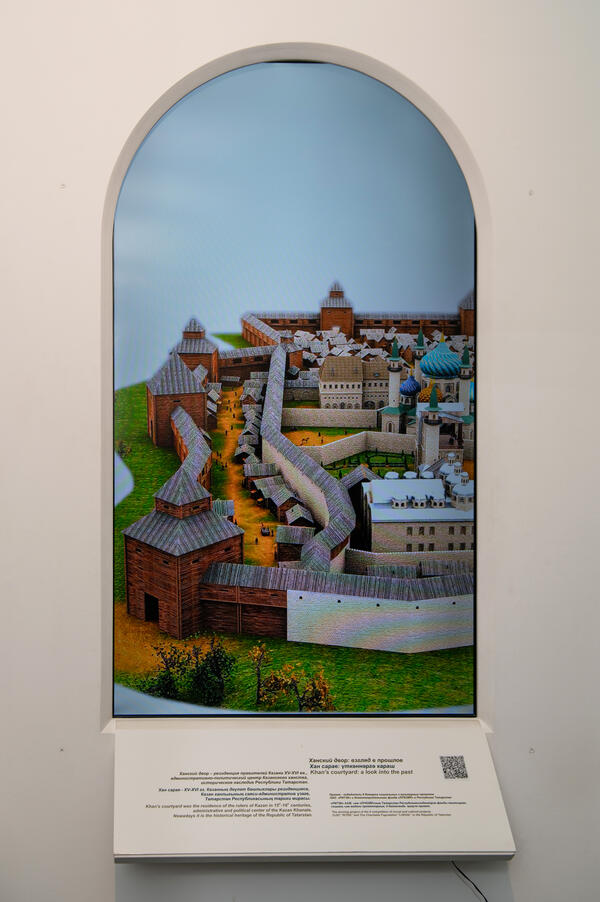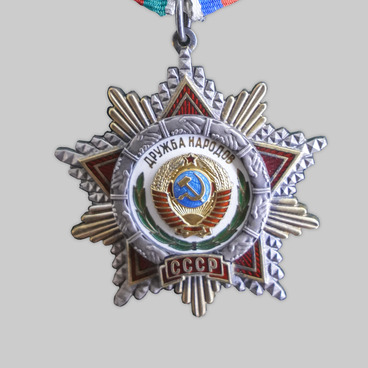Installation “Khan”s yard. A look into the past” is a window in which you can see how life looked in Kazan 500 years ago. The exhibit item visualizes the appearance of the Kazan Kremlin of the Middle Ages: the palace ensemble, the ceremony of the solemn entrance of the khan, narrow cobbled fortress streets, richly decorated palaces of nobles, merchants on the pier from distant countries.
Specialists from the design studio participated in the implementation of the project. Work on the interactive exhibit item lasted 6 months, from December 2011 to June 2012.
In the middle of the 15th century, after the collapse of the Golden Horde, Kazan became the administrative centre of the Kazan Khanate, an ancient state which existed from 1438 to 1552. At this time, the city was already a large trade and craft centre. There were trade areas and settlements with foreign craftsmen, and also concentrated various handicrafts: leather, jewellery, pottery, metallurgy. For these reasons, the first rulers made Kazan the capital, and the fortified fortress on the hill — the place of their permanent residence, the khan’s yard.
Archaeologists have found traces of 7 streets inside the fortress. Khan’s palace, Khan’s mosque, Kul-Sharif mosque and several mausoleums were located there. The researchers found a large amount of charred grain inside many buildings. This indicated that there were mills and craftsmen in the city who were engaged in threshing grain and baking bread.
Craftsmen lived in the city: metallurgists, blacksmiths, carpenters, masons, tanners, jewellers, potters. As a result of excavations on the territory of the Kazan Kremlin, archaeologists have discovered large industrial premises — workshops for the manufacture of leather and leather goods. Metallurgical (copper-smelting) forges were located in the area of the destroyed North-Eastern tower of the Kremlin. Architects had a special position in the state, Kazan acquired its appearance due to their work. The architecture of the city combined the local building traditions of the Bulgarian times and the receptions of visiting craftsmen from Turkey and Italy. Numerous findings of openwork carved decorative stones and tombstones, ornaments of plaster decorations for the interior decoration of buildings, multicoloured tiles for outdoor mosaics testified to the high level of development of urban culture.
Specialists from the design studio participated in the implementation of the project. Work on the interactive exhibit item lasted 6 months, from December 2011 to June 2012.
In the middle of the 15th century, after the collapse of the Golden Horde, Kazan became the administrative centre of the Kazan Khanate, an ancient state which existed from 1438 to 1552. At this time, the city was already a large trade and craft centre. There were trade areas and settlements with foreign craftsmen, and also concentrated various handicrafts: leather, jewellery, pottery, metallurgy. For these reasons, the first rulers made Kazan the capital, and the fortified fortress on the hill — the place of their permanent residence, the khan’s yard.
Archaeologists have found traces of 7 streets inside the fortress. Khan’s palace, Khan’s mosque, Kul-Sharif mosque and several mausoleums were located there. The researchers found a large amount of charred grain inside many buildings. This indicated that there were mills and craftsmen in the city who were engaged in threshing grain and baking bread.
Craftsmen lived in the city: metallurgists, blacksmiths, carpenters, masons, tanners, jewellers, potters. As a result of excavations on the territory of the Kazan Kremlin, archaeologists have discovered large industrial premises — workshops for the manufacture of leather and leather goods. Metallurgical (copper-smelting) forges were located in the area of the destroyed North-Eastern tower of the Kremlin. Architects had a special position in the state, Kazan acquired its appearance due to their work. The architecture of the city combined the local building traditions of the Bulgarian times and the receptions of visiting craftsmen from Turkey and Italy. Numerous findings of openwork carved decorative stones and tombstones, ornaments of plaster decorations for the interior decoration of buildings, multicoloured tiles for outdoor mosaics testified to the high level of development of urban culture.



